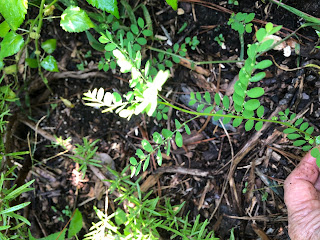Several weeks of rain, humidity, and sunshine have not only encouraged our vegetables to grow but have created a weed explosion. Weeds aren’t our enemies. They have an ecological purpose, just like all living things. But they are a nuisance and an aggravation as they insist on growing where we are trying to reshape the natural environment to our own liking. In order to attain success in our efforts, it’s good to know more about the plants we don’t want, ie weeds. Pictured here are some of the weeds you’ll see in your garden at this time of year and a few that you might want to consider leaving.
 |
| Doveweed |
The worst—Doveweed. This article from UF/IFAS explains more
https://gardeningsolutions.ifas.ufl.edu/care/weeds-and-invasive-plants/doveweed.html. Like most annual weeds, the best defense is to dig it up before it goes to seed. Chemical herbicides don’t really eradicate it.
 |
Chamberbitter
|
Chamberbitter (Phyllanthus urinaria) and its cousin Longstalked Phyllanthus (Phyllanthus tennellus). Chamberbitter forms branches close to the ground and grows in thick mounds, with seeds affixed to the underside of the lateral branches at the leaf axils. Longstalked Phyllanthus is taller, growing on a central leader with sparser branches and the seeds are on little stalks, not affixed directly to the branches. Chamberbitter is an annual and propagates from seeds which exist on the plant almost from the time it sprouts. Longstalked Phyllanthus is sometimes an annual but in subtropical climates is a perennial. Again the best remedy is careful pulling of the plants to avoid dislodging seeds, and disposing of them in heavy garbage bags with household garbage. Chamberbitter is sometimes referred to as Stonebreaker because it has been used by herbalists to dissolve kidney stones.
 |
| Long Stalked Phyllanthus |
 |
| Erect or Hyssop spurge |
Spurges—The spurge family is large and includes the Phyllanthus varieties above. The ones we often see are Spotted spurge which grows in the cracks of sidewalks forms colonies in exposed areas, and the taller erect or Hyssop spurge we see becoming noticeable in our gardens this time of year. Both are annuals which need to be pulled before they set seeds.
 |
| Pokeweed |
Pokeweed or Pokeberry—A large perennial which can take up a lot of space. Deeply rooted, it is often hard to pull up. The entire plant is poisonous to cattle and humans but the tender new growth in spring is edible (after boiling) as “Poke Salat” and in fall and winter its shiny black berries provide food for wildlife.
 |
| Spanish needle (Bidens Alba) |
Bidens Alba or Spanish Needles—A perennial or reseeding annual, which creates ambivalence in gardeners because its flowers, produced throughout summer and fall until frost, provide food for bees and other pollinators. Left alone it will colonize large areas so if you choose to leave some for the bees, control it carefully.






No comments:
Post a Comment